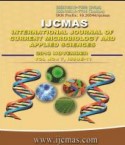


 National Academy of Agricultural Sciences (NAAS)
National Academy of Agricultural Sciences (NAAS)

|
PRINT ISSN : 2319-7692
Online ISSN : 2319-7706 Issues : 12 per year Publisher : Excellent Publishers Email : editorijcmas@gmail.com / submit@ijcmas.com Editor-in-chief: Dr.M.Prakash Index Copernicus ICV 2018: 95.39 NAAS RATING 2020: 5.38 |
Rapeseed-mustard accounts for 19.97 per cent of the total oilseeds production in India and it is one of the major contributors to Yellow Revolution. Their yield losses due to Alternaria blight was reported in the range of 10 to 70 per cent variable. The seed quality, seed size, colour and reduction of oil up to 10 per cent and seed germination ability is also adversely affected due to this disease in addition to quantities yield losses. Nine different treatment combinations of bio-agents, fungicides, micronutrients and cultural operations with a control were testing the effectiveness against the Alternaria leaf and pod blight of mustard in two consecutive crop seasons, 2011-12 and 2012-13. The integrated disease management (IDM) practice is used for reducing Alternaria leaf and pod blight and for sustaining higher yields of mustard. The use of ZnO 15 kg/ha (SA) + Borax 10kg/ha (SA) + Sulphar as basal dose + P. flurescens 10 ml/lit water (FS) against the recorded minimum disease severity and gave highest per cent disease control as compared to other treatments as 8.90, 1.59 per cent and 60.05, 80.26 per cent respectively.
 |
 |
 |
 |
 |